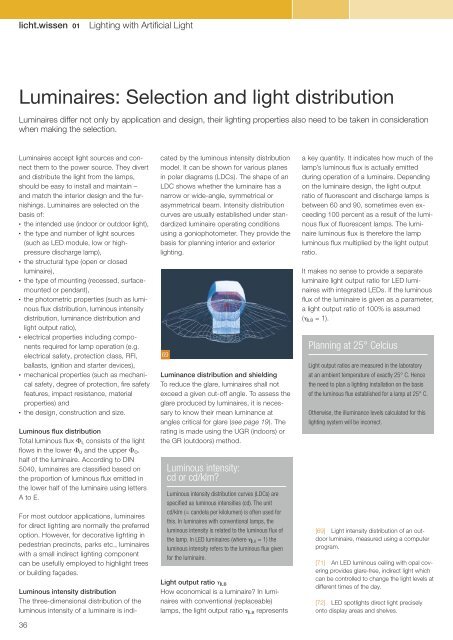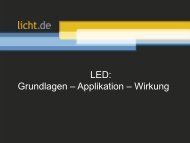licht.wissen No. 01 "Lighting with Artificial Light"
Booklet 1 is intended for all those who want to delve into the topic of light and lighting or wish to familiarize themselves with the basics of lighting technology. It also helps to make a decision in the field of lighting. Free Download at www.licht.de/en
Booklet 1 is intended for all those who want to delve into the topic of light and lighting or wish to familiarize themselves with the basics of lighting technology. It also helps to make a decision in the field of lighting. Free Download at www.licht.de/en
Create successful ePaper yourself
Turn your PDF publications into a flip-book with our unique Google optimized e-Paper software.
<strong>licht</strong>.<strong>wissen</strong> <strong>01</strong><br />
<strong>Lighting</strong> <strong>with</strong> <strong>Artificial</strong> Light<br />
Luminaires: Selection and light distribution<br />
Luminaires differ not only by application and design, their lighting properties also need to be taken in consideration<br />
when making the selection.<br />
Luminaires accept light sources and connect<br />
them to the power source. They divert<br />
and distribute the light from the lamps,<br />
should be easy to install and maintain –<br />
and match the interior design and the furnishings.<br />
Luminaires are selected on the<br />
basis of:<br />
<br />
the intended use (indoor or outdoor light),<br />
<br />
the type and number of light sources<br />
(such as LED module, low or highpressure<br />
discharge lamp),<br />
<br />
the structural type (open or closed<br />
luminaire),<br />
<br />
the type of mounting (recessed, surfacemounted<br />
or pendant),<br />
the photometric properties (such as luminous<br />
flux distribution, luminous intensity<br />
distribution, luminance distribution and<br />
light output ratio),<br />
electrical properties including components<br />
required for lamp operation (e.g.<br />
electrical safety, protection class, RFI,<br />
ballasts, ignition and starter devices),<br />
mechanical properties (such as mechanical<br />
safety, degree of protection, fire safety<br />
features, impact resistance, material<br />
properties) and<br />
<br />
the design, construction and size.<br />
Luminous flux distribution<br />
Total luminous flux L consists of the light<br />
flows in the lower U and the upper O .<br />
half of the luminaire. According to DIN<br />
5040, luminaires are classified based on<br />
the proportion of luminous flux emitted in<br />
the lower half of the luminaire using letters<br />
A to E.<br />
For most outdoor applications, luminaires<br />
for direct lighting are normally the preferred<br />
option. However, for decorative lighting in<br />
pedestrian precincts, parks etc., luminaires<br />
<strong>with</strong> a small indirect lighting component<br />
can be usefully employed to highlight trees<br />
or building façades.<br />
36<br />
Luminous intensity distribution<br />
The three-dimensional distribution of the<br />
luminous intensity of a luminaire is indicated<br />
by the luminous intensity distribution<br />
model. It can be shown for various planes<br />
in polar diagrams (LDCs). The shape of an<br />
LDC shows whether the luminaire has a<br />
narrow or wide-angle, symmetrical or<br />
asymmetrical beam. Intensity distribution<br />
curves are usually established under standardized<br />
luminaire operating conditions<br />
using a goniophotometer. They provide the<br />
basis for planning interior and exterior<br />
lighting.<br />
69<br />
Luminance distribution and shielding<br />
To reduce the glare, luminaires shall not<br />
exceed a given cut-off angle. To assess the<br />
glare produced by luminaires, it is necessary<br />
to know their mean luminance at<br />
angles critical for glare (see page 19). The<br />
rating is made using the UGR (indoors) or<br />
the GR (outdoors) method.<br />
Luminous intensity:<br />
cd or cd/klm?<br />
Luminous intensity distribution curves (LDCs) are<br />
specified as luminous intensities (cd). The unit<br />
cd/klm (= candela per kilolumen) is often used for<br />
this. In luminaires <strong>with</strong> conventional lamps, the<br />
luminous intensity is related to the luminous flux of<br />
the lamp. In LED luminaires (where LB = 1) the<br />
luminous intensity refers to the luminous flux given<br />
for the luminaire.<br />
Light output ratio LB<br />
How economical is a luminaire? In luminaires<br />
<strong>with</strong> conventional (replaceable)<br />
lamps, the light output ratio LB represents<br />
a key quantity. It indicates how much of the<br />
lamp’s luminous flux is actually emitted<br />
during operation of a luminaire. Depending<br />
on the luminaire design, the light output<br />
ratio of fluorescent and discharge lamps is<br />
between 60 and 90, sometimes even exceeding<br />
100 percent as a result of the luminous<br />
flux of fluorescent lamps. The luminaire<br />
luminous flux is therefore the lamp<br />
luminous flux multiplied by the light output<br />
ratio.<br />
It makes no sense to provide a separate<br />
luminaire light output ratio for LED luminaires<br />
<strong>with</strong> integrated LEDs. If the luminous<br />
flux of the luminaire is given as a parameter,<br />
a light output ratio of 100% is assumed<br />
( LB = 1).<br />
Planning at 25° Celcius<br />
Light output ratios are measured in the laboratory<br />
at an ambient temperature of exactly 25° C. Hence<br />
the need to plan a lighting installation on the basis<br />
of the luminous flux established for a lamp at 25° C.<br />
Otherwise, the illuminance levels calculated for this<br />
lighting system will be incorrect.<br />
[69] Light intensity distribution of an outdoor<br />
luminaire, measured using a computer<br />
program.<br />
[71] An LED luminous ceiling <strong>with</strong> opal covering<br />
provides glare-free, indirect light which<br />
can be controlled to change the light levels at<br />
different times of the day.<br />
[72] LED spotlights direct light precisely<br />
onto display areas and shelves.

















